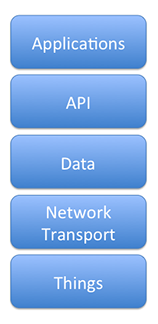When I flip through a book on networking, one of the first things I look for is the protocol stack diagram. An elegant representation of the protocol stack can help you make sense of where to put things, separate out important mental concepts, and help explain how a technology is organized.
I’m no stranger to the idea of trying to diagram out a protocol space; I had a successful effort back when the second edition of my book on 802.11 was published. I’ve been a party to several awesome conversations recently about how to organize the broad space that’s referred to as the “Internet of Things.”
Let’s start at the bottom, with the hardware layer, which is labeled Things. These are devices that aren’t typically thought of as computers. Sure, they wind up using a computing ecosystem, but they are not really general-purpose computers. These devices are embedded devices that interact with the physical world, such as sensors and motors. Primarily, they will either be the eyes and ears of the overall system, or the channel for actions on the physical world. They will be designed around low power consumption, and therefore will use a low throughput communication channel. If they communicate with a network, it will typically be through a radio interface, but the tyranny of limited power consumption means that the network interface will usually be limited in some way.
Things provide their information or are instructed to act on the world by connecting through a Network Transport layer. Networking allows reports from devices to be received and acted on. In this model, the network transport consists of a set of technologies that move data around, and is a combination of the OSI data link, networking, and transport layers. Mapping into technologies that we use, it would be TCP/IP on Wi-Fi for packet transport, with data carried over a protocol like REST.
The Data layer aggregates many devices into an overall collective picture. In the IoT world, users are interacting with the physical world and asking questions like “what is the temperature in this room?” That question isn’t answered by just one device (or if it is, the temperature of the room is likely to fluctuate wildly). Each component of the hardware layer at the bottom of the stack contributes a piece of the overall contextual picture. A light bulb can be on or off, but to determine the desired state, you might mix in overall power consumption of the building, how many people are present, the locations of those people, total demand on the electrical grid, and possibly even the preferences of the people in an area. (I once toured an FAA regional air traffic control center, and the groups of controllers that serve each sub-region of airspace could customize the lighting, ranging from normal lighting to quite dim lighting.)
The value of the base level of devices in this environment depends on how much unique context it can add to the overall picture and enable the operation of software that can operate on concepts of the physical world like room temperature or whether I am asleep. Looking back on it, the foundation for the data layer was being laid years ago, as is obvious reading section three of Tim O’Reilly’s “What is Web 2.0?” essay from 2005. In this world, you are either contributing to or working with context, or you are not doing very interesting work.
Sharing context widely requires APIs. If the real-world import of a piece of data is only apparent when it is combined with other sources of data, an application needs to be able to mash up several data sources to create its own unique picture of the world. APIs enable programmers to build context that represents what is important to users and build a cognitively significant aggregation. “Room temperature” may depend on getting data from temperature, humidity, and sunlight sensors, perhaps in several locations in a room.
In addition to reporting up, APIs need to enable control to flow down the stack. If “room temperature” is a complex state that depends on data from several sensors, it may require acting on several aspects of a climate control system to change: the heater, air conditioner, fan, and maybe even whether the blinds in a room are open or closed.
Designing APIs is hard; in addition to getting the data operations and manipulation right, you need to design for performance, security, and to enable applications over time. A good place to start is O’Reilly’s API strategy guide.
Finally, we reach the top of the stack when we get to Applications. Early applications allowed you to control the physical world like a remote control. Nice, but by no means the end of the story. One of the smartest technology analysts I know often challenges me by saying, “It’s great that you can report anomalous behavior. If you know something is wrong, do something about it!” The “killer app” in this world is automation: being able to work without explicit instructions from the user, or to continuously fine-tune and optimize the real world based on what has flowed up the stack.
Unlike my previous effort in depicting the world of 802.11, this stack is very much a work in progress. Please leave your thoughts in the comments.
